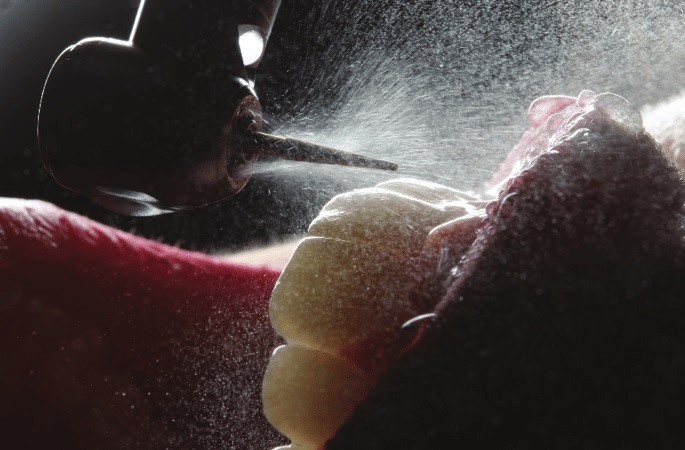 TRUE VALUE DENTAL INSTITUTE
TRUE VALUE DENTAL INSTITUTE

Blog By: Dr. Shivangi, True Value Dental Institute
COVID-19 is a significant pandemic that has crippled society over the past few months. The shutting of economies and the introduction of “social distancing” was a necessary response to reduce the rate of new infections and prevent overloading of our health-care systems. As such, dental clinics, along with most other non-essential businesses, have been asked to cease operations to reduce social contacts and in turn, protect the public.
In the past few months, some members of our dental community have expressed concern that Aerosol Generating Dental Procedures (AGDPs) could facilitate the infective transmission of the SARS-CoV-2 virus and endanger dental staff and patients. This article aims to be a rational, data-based evaluation of the research and available evidence.
Virus Transmission vs Disease Infection

- SARS-CoV-2 is the virus, COVID-19 is the disease and Corona is the common “street” name.
- Transmission of a virus does not mean infection with the disease.
- It is established that the SARS-CoV-2 virus can infect a host via droplet and contact transmission, whereas acquiring COVID-19 disease via airborne transmission remains unlikely.
- The minimal infectious dose can be defined as is the minimum dose of viral particles that can initiate disease depending on host susceptibility and immune response.
- The probability of getting infected, as well as the severity of disease, are dose-dependent.
- Protect the susceptible portals of entry: mucus membranesàthe nose, the mouth and the eyes.
- Shield these areas with appropriate personal protective equipment (PPE).
Aerosols: Droplet Transmission and Airborne Transmission
- Common Namesà “aerosols,” “droplets,” “droplet nuclei,” “airborne,” and “solid particulates.”
- “Aerosols” are solid or liquid particles that are suspended in the air; they are often invisible.
- Aerosols can be divided into large droplets and small droplets.
- Researchers use the term “droplet” for larger droplets and the term “aerosols” for smaller droplets.
- Large droplets behave ballistically and tend to be falling when they infect the recipient. This mode of transmission is known as “droplet transmission“.
- Large droplets may also contaminate objects and be transferred to mucous membranes by way of touch. This is called “contact transmission “.
- Small droplets stay suspended in the air for a variable amount of time, or they evaporate and change into a solid particulate “droplet nuclei” that float freely. The transmission of these small droplets is known as “airborne transmission“.
Aerosol Generating Procedures (AGPs)

- An aerosol generating procedure (AGP) is a medical or dental intervention that has the potential of creating aerosols in addition to those that patients naturally produce during breathing, speaking, sneezing and coughing.
- AGPs produce both small and large droplets, and each AGP creates a different pattern and composition of aerosols. Therefore, it is inaccurate to conclude that generating aerosols will cause infection.
- It is also inaccurate to grant equivalency between the aerosol generating medical procedures (AGMPs) and the aerosol generating dental procedures (AGDPs).
- The aerosol composition differs considerably even amongst AGMPs: for instance, certain AGMPs generate aerosols by inducing the patient to cough. It has been shown that coughing emits up to 1000 times the number of droplets compared to normal breathing.

Dental Aerosols are Not Infectious
- Decades of precedent exist showing that the dentists have routinely (but unknowingly) generated aerosols in patients infected by pathogens.
- The dental aerosols of 2020 are only marginally changed from those of 2019 and before. Now they may also contain the SARS-CoV-2 virus in addition to the multitudes of previous pathogens.
- There is no evidence that the viral load of the 2020 dental aerosols is more infectious than that of those previously encountered.
- The use of high-volume evacuation and routine PPE has protected dentists, staff and patients from cluster infections. If this were not the case, there would already be ample evidence to the contrary.
- The recent closure of dental offices was about “social distancing,” it was never about dental aerosols.
- Aerosols from certain medical procedures can be extremely hazardous. Tragic infection and death of health-care workers during the SARS and Ebola outbreaks crystalized this awareness.
- The use of enhanced PPE and other airborne precautions is wholly appropriate for those medical interventions on infectious COVID-19 patients.
- However, medically and dentally generated aerosols are not the same: in our rush to judgement, we have conflated these two very different types of interventions.
What Are the Real Dangers?
We believe there are two primary concerns in the current regulatory environment:
- Unfounded emphasis on dental aerosol mitigation is a “red herring,” which might distract us from the real transmission risk in a dental office – the non-clinical areas.
- Non-clinical areas are where higher viral doses from sustained speaking (and perhaps even coughing and sneezing) may occur, possibly without masks, and certainly without the benefit of high-volume evacuation.
- We believe it is imperative to enforce protocols designed to protect staff and patients in the non-clinical spaces of dental offices.
2. Unfounded emphasis on dental aerosol mitigation has created a false impression that visits to the dentist are dangerous. Patients are unquestionably safer in dental offices than in most other social settings. Yet if the public perceives visits to the dentist as a health risk, their dental health will inevitably suffer.
Conclusion
The main reason dental operatories may become infective depends on the exposure of the non-clinical areas, their incomplete/defective disinfection and less air changes per hour (ACH). Therefore, emphasizing on the dental aerosols responsible for active infection is not based on strong evidences.
Reference:
- Mair D. A, Korne H. P. Decoding Dental Aerosols. Available from: https://secibonline.com/wp-content/uploads/2020/05/Decoding-Dental-Aerosols_May-212020.pdf

 Click here for Dental Services
Click here for Dental Services